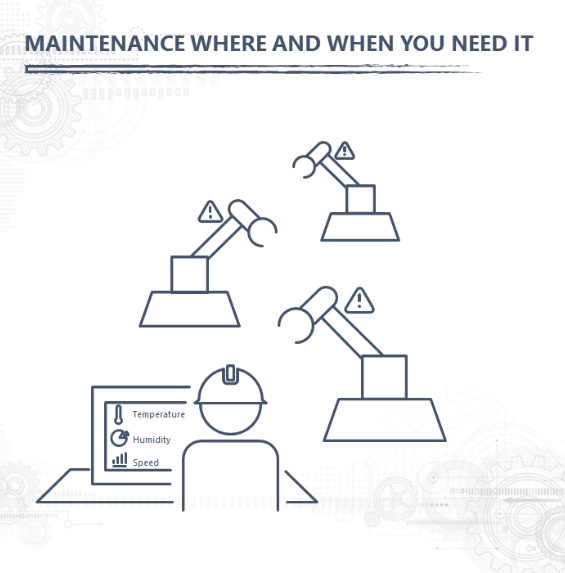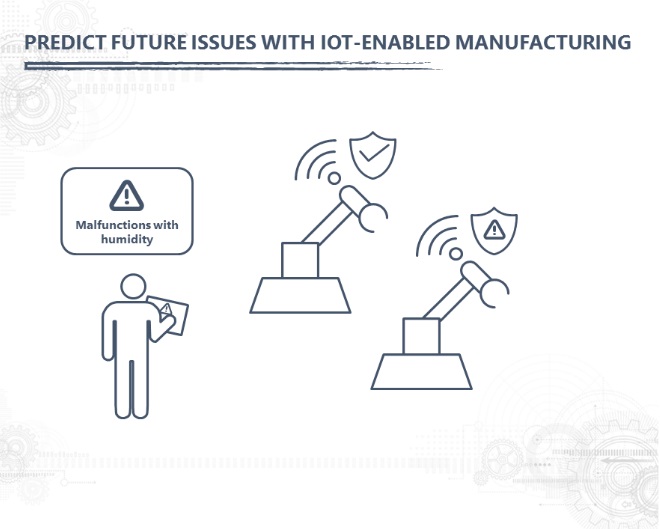
Reduce maintenance costs and improve utilization
Modern manufacturing is an equipment intensive business. It depends on machines for high volume, high quality output of products and components. Therefore, one of the highest priorities of the modern manufacturing business is keeping equipment running optimally.
In some industries, such as automotive and high tech manufacturing, the equipment must not only be kept running but kept performing at very tight tolerances. Small changes in tool wear or even ambient temperature can impact the quality of the product being manufactured.
 Machines that go out of spec create product of unacceptable quality. Downtime is even worse. It’s estimated that manufactures lose hundreds of hours of downtime a year. For auto manufacturers, this can mean losing $22,000 per minute they are offline. That amounts to $1.3 million per month. When this downtime is not planned, the maintenance cost can be 10x what it would cost if it was planned.
Machines that go out of spec create product of unacceptable quality. Downtime is even worse. It’s estimated that manufactures lose hundreds of hours of downtime a year. For auto manufacturers, this can mean losing $22,000 per minute they are offline. That amounts to $1.3 million per month. When this downtime is not planned, the maintenance cost can be 10x what it would cost if it was planned.
Keeping equipment running and in-spec is one of manufacturers’ primary goals. Yet, industrial equipment gets more complicated every day. How can manufactures ensure they can keep their production lines running efficiently?
A traditional method for minimizing downtime is scheduling regular maintenance. Based on statistical information, machines are scheduled for things like filter and fluid changes, wear item replacements, and testing. This approach can minimize unanticipated downtime but can also lead to potentially unnecessary time losses and costs. For instance, a maintenance schedule that calls for a filter change every 1000 hours is based on ‘average’ conditions, and in some cases, it may be that the filter can go much longer. In addition, anomalous problems may be missed with if inspection or measurement isn’t included in the regular maintenance schedule.
 All this is beginning to change. Given the dramatic decrease in the cost of sensors and the ubiquity of the internet, leading manufacturers are moving away from relying solely on scheduled maintenance to a more sophisticated “Internet of Things” (IoT) approach to equipment maintenance.
All this is beginning to change. Given the dramatic decrease in the cost of sensors and the ubiquity of the internet, leading manufacturers are moving away from relying solely on scheduled maintenance to a more sophisticated “Internet of Things” (IoT) approach to equipment maintenance.
IoT sensors can collect data from machines including air and fluid flow, temperature, vibration, and other key properties. For individual machines, this can provide a much more accurate picture of the health of the system and the need for service. Maintenance personnel can be dispatched to equipment needing service when, and only when, it needs attention, and with the proper parts and tools, reducing repeat trips and reducing downtime. Having more data available about the health of the machine and the parts that will be needed to repair it make it more likely problems can be fixed the first time, without the need for return visits. Machine learning, a technology that takes huge amounts of data and find patterns that may not readily obvious, makes this type of information available to the stakeholders who need it.
Just as importantly, the collected data from the shop floor can be consolidated into dashboards that can provide an ‘at-a-glance’ overview of the entire production facility. This helps optimize the time of service personnel and optimize spare parts inventory. Data can be used with machine learning technology to find patterns that might otherwise escape the notice of the maintenance team, both to predict future equipment issues and calculate the remaining useful life of equipment.
 Machine learning also enables equipment owners to detect problems that were previously difficult or even impossible to identify. For instance, the performance of precision equipment might vary slightly under differing heat and humidity conditions or tool wear. Without something to monitor these variations throughout the day, it becomes possible to get to the end of a production with an entire batch of product that is out of tolerance – despite the fact that nothing actually shut down or failed. Determining the effect of several concurrent environmental conditions would be difficult or impossible using traditional methods, but with machine learning and a wide range of data sources these patterns can quickly be found and acted upon. Machine learning effectively enables you to detect problems that are too small to notice or product variants that would otherwise be difficult to find root cause after the fact.
Machine learning also enables equipment owners to detect problems that were previously difficult or even impossible to identify. For instance, the performance of precision equipment might vary slightly under differing heat and humidity conditions or tool wear. Without something to monitor these variations throughout the day, it becomes possible to get to the end of a production with an entire batch of product that is out of tolerance – despite the fact that nothing actually shut down or failed. Determining the effect of several concurrent environmental conditions would be difficult or impossible using traditional methods, but with machine learning and a wide range of data sources these patterns can quickly be found and acted upon. Machine learning effectively enables you to detect problems that are too small to notice or product variants that would otherwise be difficult to find root cause after the fact.
Employing an IoT approach for predictive maintenance of equipment can greatly reduce costs and downtime and improve a manufacturer’s production and bottom line dramatically. For more information on how Microsoft solutions can be applied to predictive maintenance.
| Learn More |




